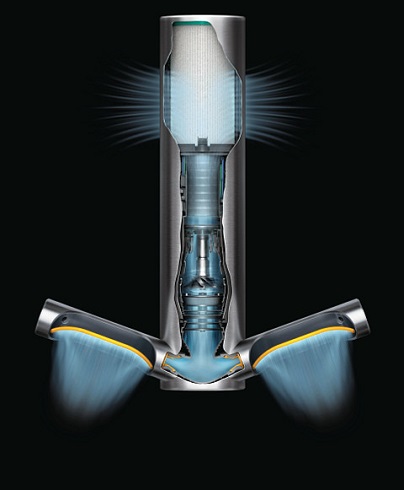 Thursday, April 25, 2024
Thursday, April 25, 2024  Thursday, April 25, 2024
Thursday, April 25, 2024 
Dyson is pleased to introduce the Dyson Airblade 9kJ hand dryer. With a completely unique design and cutting-edge technology, the Dyson Airblade 9kJ hand dryer enables people to dry their hands quickly and hygienically, while using low energy and offering an alternative to single-use paper towels.
“At Dyson we believe hand drying should be fast, hygienic and responsible in its energy use. We solved many of these problems when we disrupted the industry with the launch of the first Dyson Airblade™ in 2006,” explains Jake Dyson, Chief Engineer. “We continue to pioneer with the Dyson Airblade 9kJ hand dryer – our latest hand drying technology. From the acoustics to its design, everything has been rethought to deliver the best performance without any compromise on user experience or hygiene.”
The Dyson Airblade 9kJ hand dryer has been in development for more than three years, with more than 700 prototypes made. The result is the quietest Dyson Airblade™ hand dryer yet, with fast hand drying in 10 seconds. Our motor and airflow technology allow the new Dyson Airblade 9kJ hand dryer to use up to 86% less energy than warm air dryers in Eco mode, while producing up to 85% less carbon dioxide emissions per dry than paper towels.
“It is the instinct of engineers to want to improve things, make them more efficient and to use fewer resources in the process. It is wired into our DNA and it is this urge which drives progress and advancement – even in the washroom,” explains James Dyson. “In 1907 paper towels were first introduced, and the electric hand dryer made its first appearance in 1948 – but both have their failings. The journey to find a better way is fascinating. In 2006, the invention of Dyson Airblade™ technology meant that, for the first time, water was scraped off hands using high velocity unheated air, thus reducing the energy consumption,” he adds.
As always with Dyson, success is in the detail and the intelligent combination of hardware and software. The Dyson Airblade 9kJ hand dryer’s robust design and stainless steel body is built to last and rigorously tested to withstand real-life washroom conditions. It also employs pioneering Dyson technology including:
Two modes
This is the first Dyson AirbladeTM to feature two modes – Max and Eco. Max mode is designed for washrooms with high footfall that want to optimize for speed, while Eco mode is recommended for washrooms with relatively lower footfall who want to optimize for energy consumption and noise reduction. This is the first time Dyson has offered such customization to customers.
A Curved Blade™ design
Powered by the Dyson digital motor V4, which spins at up to 75,000 rpm, sheets of air flow up to 388 mph through two 0.018 inch curved apertures that follow the contours of your hands, removing water in less time. Many calculations were carried out by Dyson engineers to determine the most ergonomic drying angle. The blades are positioned at an angle of 70 degrees for fast, comfortable hand drying.
Our powerful Dyson digital motor V4 shifts 23 liters of air per second, allowing the Dyson Airblade 9kJ hand dryer to dry your hands fast, in just 10 seconds.
The Dyson Airblade 9kJ hand dryer uses 9.1 kilojoules of energy per dry in Eco mode, meaning it costs just about $19 a year to run in that mode.
Touch-free operation
The machine uses ‘time of flight’ sensors that accurately detect hands to activate air. The sensors are calibrated to detect hands in 0.25 seconds for quick activation. Similarly, once hands are out of the area covered by the sensor the machine will stop quickly.
Hygienic HEPA filtration
Unique to Dyson is our in-house microbiology lab. This lab allows teams working on products to continuously test and reflect the findings of these tests in the development of our machines so we can always be improving them. Hygiene is a critical factor in restrooms. With that in mind, the Dyson Airblade 9kJ hand dryer features a fleece-lined glass fiber HEPA filter, which captures 99.97% of particles, including bacteria and viruses from the washroom air so the machine uses clean air to dry hands.
In addition, the body of the machine is made from stainless steel for easy cleaning and maintenance.
Acoustically engineered
Our quietest Dyson Airblade™ hand dryer yet2, the Dyson Airblade 9kJ hand dryer features silencers made from open-cell foam and perforated discs, reducing noise as airflow passes through the motor.
To achieve the reduction in noise, Dyson re-designed the airflow paths through the machine to create a straight line configuration. This allows for a simpler airflow path which reduces air turbulence and therefore reducing sound output. The new straight line configuration also helps with less energy consumption.
The motor housing of the Dyson digital motor V4 regulates airflow paths through the motor, reducing noisy turbulence. The motor is mounted on silicone rubber to further reduce noise, and the specially designed open-cell foam silencers absorb vibrations from air entering and exiting the motor.
The Dyson Airblade 9kJ hand dryer costs $1,499 and is designed to suit any commercial or public washroom from offices, shopping malls and restaurants to public spaces, amusement parks, schools, hospitals and hotels.
About
Dyson is a global technology enterprise with engineering and testing operations in Malaysia, Singapore, the Philippines and the UK. Dyson employs over 12,700 people globally, including 5,750 engineers and scientists – with an increasing proportion in South East Asia where production and operations also take place. Dyson is realizing ambitious plans to develop new technologies with global teams focused solid state battery cells, high-speed electric motors, vision systems, machine learning technologies, and A.I.